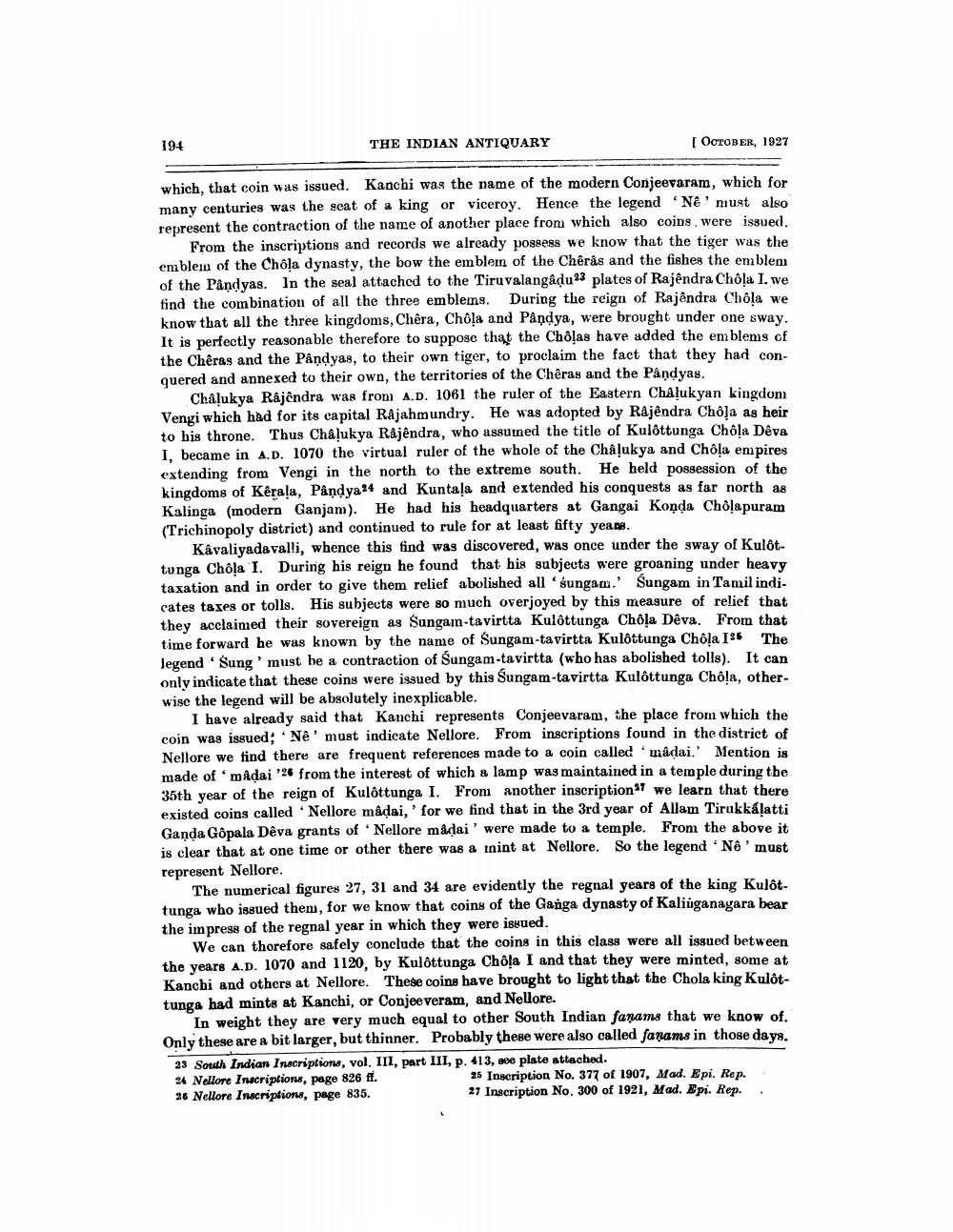________________
194
THE INDIAN ANTIQUARY
[OCTOBER, 1927
which, that coin was issued. Kanchi was the name of the modern Conjeevaram, which for many centuries was the seat of a king or viceroy. Hence the legend 'Ne' must also represent the contraction of the name of another place from which also coins were issued.
From the inscriptions and records we already possess we know that the tiger was the emblem of the Chola dynasty, the bow the emblem of the Chêrås and the fishes the emblem of the Påndyas. In the seal attached to the Tiruvalangadu 23 plates of Rajendra Chola I. we find the combination of all the three emblems. During the reign of Rajendra Chola we know that all the three kingdoms, Chêra, Chola and Pandya, were brought under one sway. It is perfectly reasonable therefore to suppose that the Cholas have added the emblems of the Cheras and the Påndyas, to their own tiger, to proclaim the fact that they had conquered and annexed to their own, the territories of the Cheras and the Pandyag.
Chalukya Rajendra was from A.D. 1061 the ruler of the Eastern Chalukyan kingdom Vengi which had for its capital Rajahmundry. He was adopted by Rajendra Chola as heir to his throne. Thus Châļukya Rajendra, who assured the title of Kulottunga Chola Deva I, became in A.D. 1070 the virtual ruler of the whole of the Chåļukya and Chola empires extending from Vengi in the north to the extreme south. He held possession of the kingdoms of Kerala, Pandya 24 and Kuntala and extended his conquests as far north as Kalinga (modern Ganjam). He had his headquarters at Gangai Konda Cholapuram (Trichinopoly district) and continued to rule for at least fifty yeans.
Kâvaliyadavalli, whence this find was discovered, was once under the sway of Kulottunga Chôļa 1. During his reign he found that his subjects were groaning under heavy taxation and in order to give them relief abolished all ‘śungam.' Sungam in Tamil indicates taxes or tolls. His subjects were so much overjoyed by this measure of relief that they acclaimed their sovereign as Sungai-tavirtta Kulôttunga Chola Dêva. From that time forward he was known by the name of Sungam-tavirtta Kulottunga Chola 125 The legend Sung 'must be a contraction of Sungam-tavirtta (who has abolished tolls). It can only indicate that these coins were issued by this Sungam-tavirtta Kulôttunga Chola, otherwise the legend will be absolutely inexplicable.
I have already said that Kanchi represents Conjeevaram, the place from which the coin was issued; Nê' must indicate Nellore. From inscriptions found in the district of Nellore we find there are frequent references made to a coin called 'madai.' Mention is made of mAdai '26 from the interest of which a lamp was maintained in a temple during the 35th year of the reign of Kulôttunga I. From another inscriptionwe learn that there existed coins called Nellore madai,' for we find that in the 3rd year of Allam Tirukkálatti Ganda Gôpala Deva grants of Nellore madai' were made to a temple. From the above it is clear that at one time or other there was a inint at Nellore. So the legend 'Nê' must represent Nellore.
The numerical figures 27, 31 and 34 are evidently the regnal years of the king Kulottunga who issued them, for we know that coins of the Ganga dynasty of Kaliūganagara bear the impress of the regnal year in which they were isvued.
We can thorefore safely conclude that the coins in this class were all issued between the years A.D. 1070 and 1120, by Kulôttunga Chôļa I and that they were minted, some at Kanchi and others at Nellore. These coins have brought to light that the Chola king Kulttunga had mints at Kanchi, or Conjeeveram, and Nellore.
In weight they are very much equal to other South Indian fanams that we know of. Only these are a bit larger, but thinner. Probably these were also called fanams in those days.
33 South Indian Inscriptions, vol. III, part III, p. 413, se plate attached. 24 Nellore Inscriptions, page 826 ff.
25 Inscription No. 377 of 1907, Mad. Epi. Rep. 26 Nellore Inscriptions, page 835.
27 Inscription No. 300 of 1921, Mad. Epi. Rep. .




